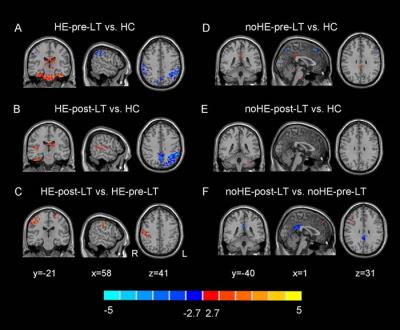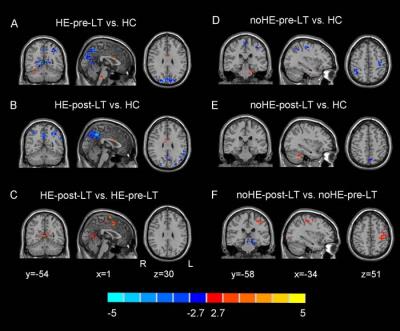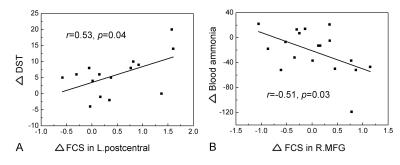5291
Impact of previous episodes of hepatic encephalopathy on post-transplantation brain function recoveryYue Cheng1 and Wen Shen2
1Tianjin First Central Hospital, Tianjin, People's Republic of China, 2Tianjin First Central Hospital, People's Republic of China
Synopsis
Purpose: To investigate the impact of prior episodes of hepatic encephalopathy (HE) on post-transplantation brain function recovery. Method: Thirty-three cirrhotic patients (HE, n=15 and noHE, n=18) and 30 healthy controls were included. Functional connectivity strength (FCS) were compared between the pre-LT data and the post-LT data, respectively. Results: For the noHE group, the altered FCS found pre-LT largely returned to nearly normal levels soon after LT. The abnormal FCS prior to LT was largely preserved in the HE group, including high-level cognition-related and vision-related areas. Conclusion: Pre-LT episode of HE may have adverse effects on post-LT brain function recovery.
416
Purpose: Neuropsychological studies have documented an incomplete reversal of pre-existing cognitive dysfunction in cirrhotic patients even after liver transplantation (LT); this is more severe in patients with hepatic encephalopathy (HE). In this study, we aimed to investigate the impact of prior episodes of HE on post-transplantation brain function recovery. Method: This study approved by institutional review board, and all the subjects’ written informed consents were obtained before the study. Resting-state functional magnetic resonance imaging data was collected from 30 healthy controls and 33 cirrhotic patients (HE, n=15 and noHE, n=18) before and one month after LT. The liver dysfunction was determined according to the Child-Pugh score. The cognitive function of cirrhotic patients was evaluated by using number connection test-A and digit-symbol test. Both neuropsychological tests were repeated after LT. After data pre-processing, the long- and short-range functional connectivity strength (FCS) were calculated. To explore the long- and short-range FCS differences, a second-level two-sample t-test was conducted between the HE/noHE-Pre-LT group and HCs and between the HE/noHE-Post-LT group and HCs. To explore how LT affected patients’ brain function, paired t-tests were conducted to analyze any differences in long- and short- range FCS before and after LT (both HE and noHE groups). Correlation analysis was conducted to explore the relationship between the pre- and post-LT changes of FCS and the changes of neuropsychological tests. Results: Long- and short-range functional connectivity strength (FCS) analysis revealed that cirrhotic showed diffuse abnormalities of FCS relative to healthy controls before transplantation. For the noHE group, the altered FCS found pre-LT largely returned to nearly normal levels soon after LT, except for in the cerebellum, precuneus, and orbital middle frontal gyrus. However, the abnormal FCS prior to LT was largely preserved in the HE group, including high-level cognition-related (frontal and parietal lobes) and vision-related areas (occipital lobe, cuneus, and precuneus) (Fig.1-2). Changes in FCS in the left postcentral and right middle frontal gyrus correlated with neuropsychological performance and ammonia levels(r=0.53, -0.51, respectively) (Fig.3). Conclusion: We compared the difference between pre- and post-LT functional connectivity and compared this difference between LT recipients with and without a history of episodes of HE. This may help uncover the underlying mechanisms of the short-term effect of LT on cirrhotic patients. The worse restoration in the HE group demonstrates obviously adverse effects of HE on post-LT brain function recovery, providing new evidence for HE-related brain damage. Moreover, the results suggest that FCS mapping may provide new neuroimaging biomarkers to monitor the effect of LT on cognitive deficit reversibility.Acknowledgements
No acknowledgement found.References
No reference found.Figures

Regions showing significant long-range FCS differences in HE group when
comparing pre-LT with HCs (A), post-LT with HCs (B), and post-LT with pre-LT
patients (C), and regions showing significant long-range FCS differences in noHE group when
comparing pre-LT with HCs (D), post-LT with HCs (E), and post-LT with pre-LT
patients (F) (p<0.05, AlphaSim
corrected).

Regions showing significant short-range FCS differences in HE group when
comparing pre-LT with HCs (A), post-LT with HCs (B), and post-LT with pre-LT
patients (C), and regions showing significant long-range FCS differences in noHE group when
comparing pre-LT with HCs (D), post-LT with HCs (E), and post-LT with pre-LT
patients (F) separately (p<0.05,
AlphaSim corrected).

Correlation between changes
of FCS in left postcentral gyrus with that of DST in HE group (A, r=0.53, p=0.04) and changes of FCS in right MFG
with that of ammonia in noHE group (B, r=-0.51, p=0.03).